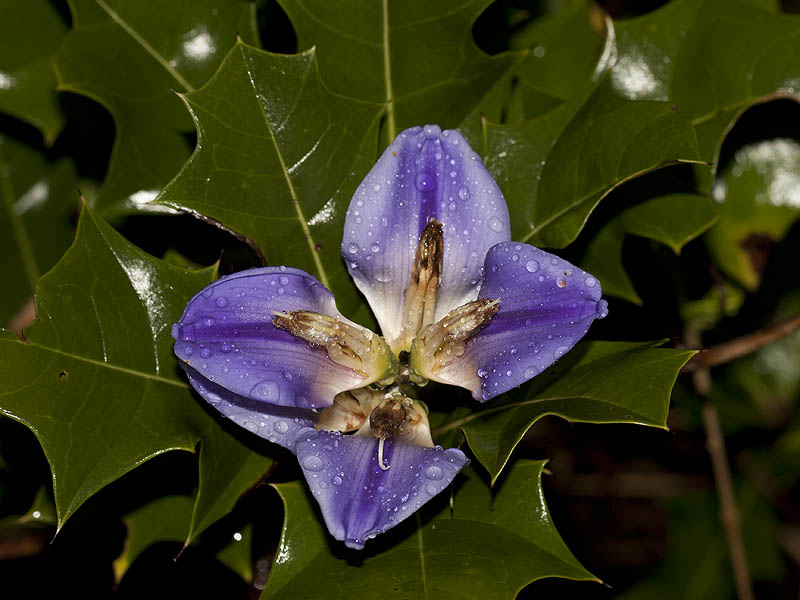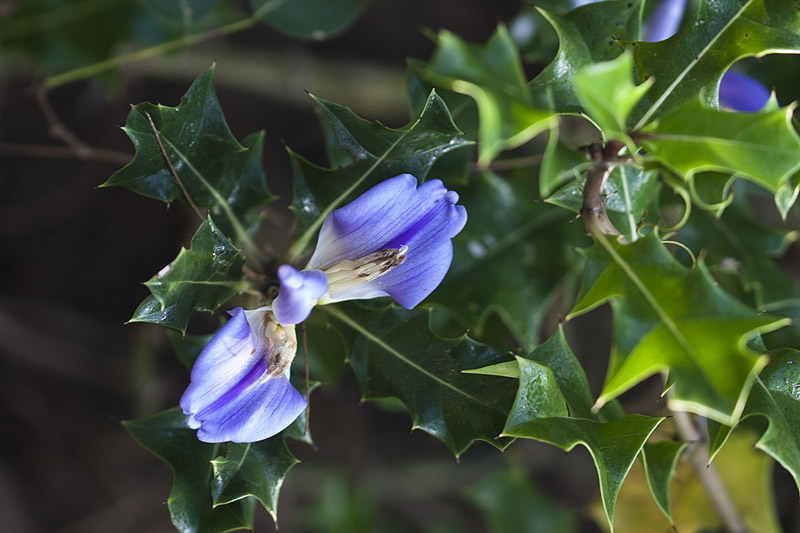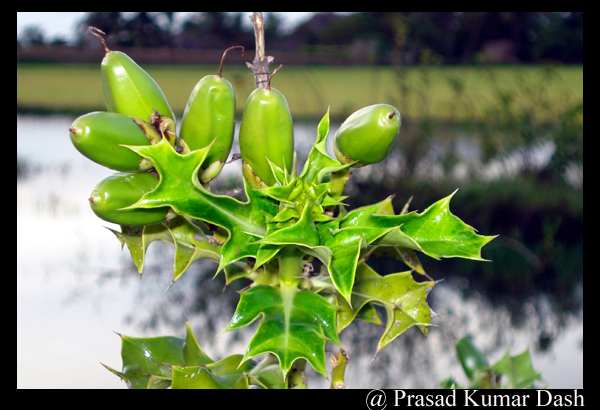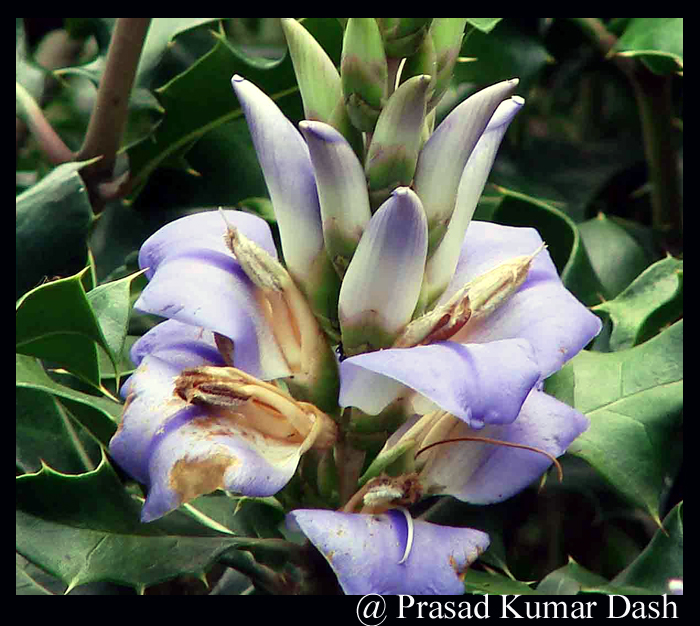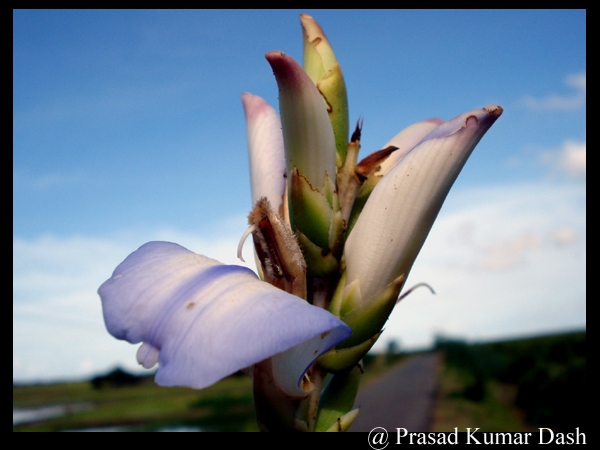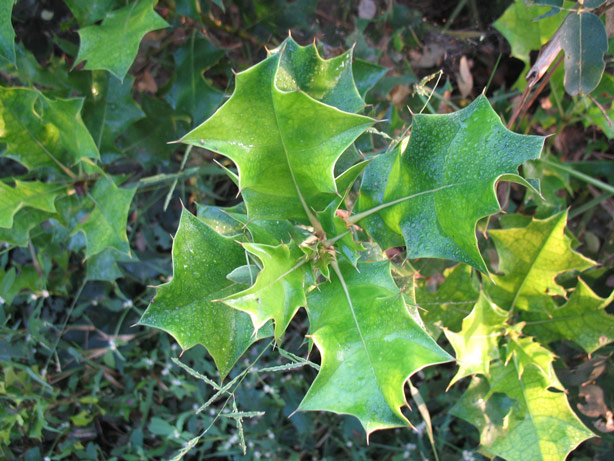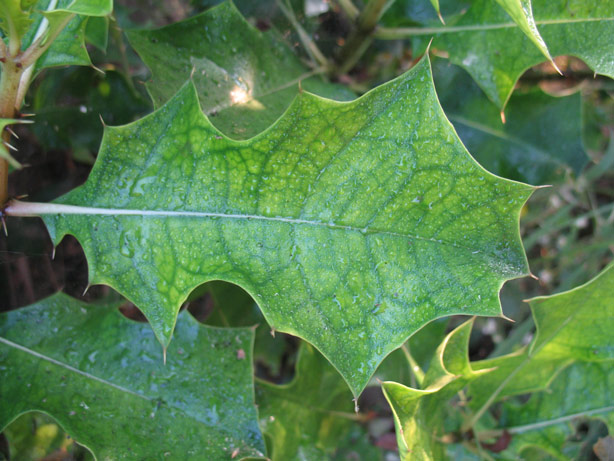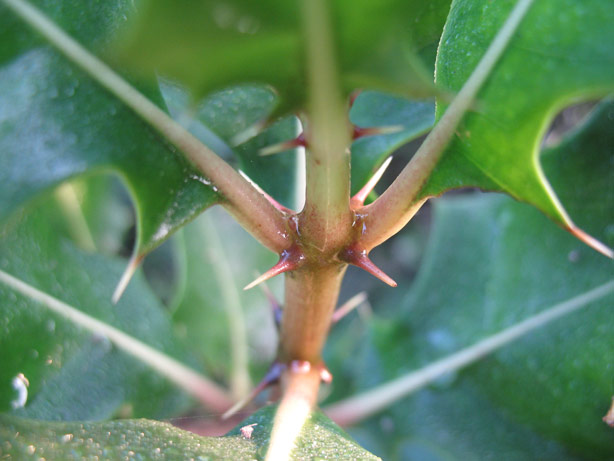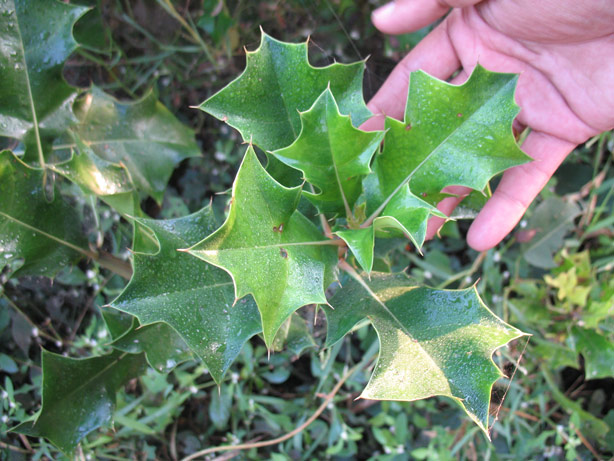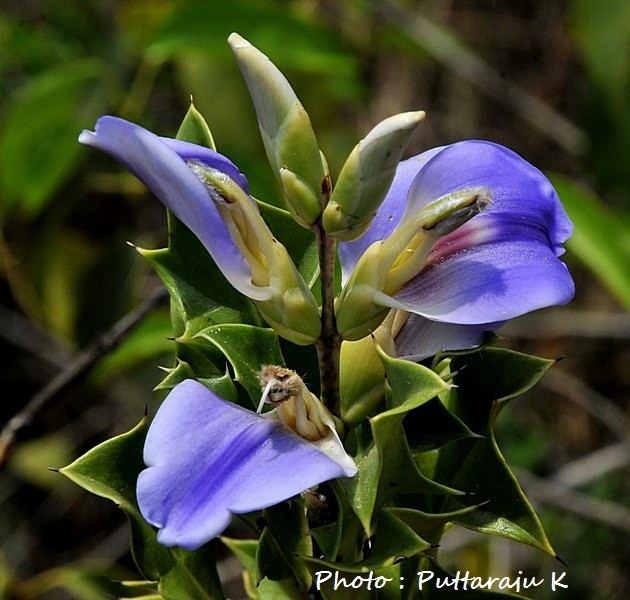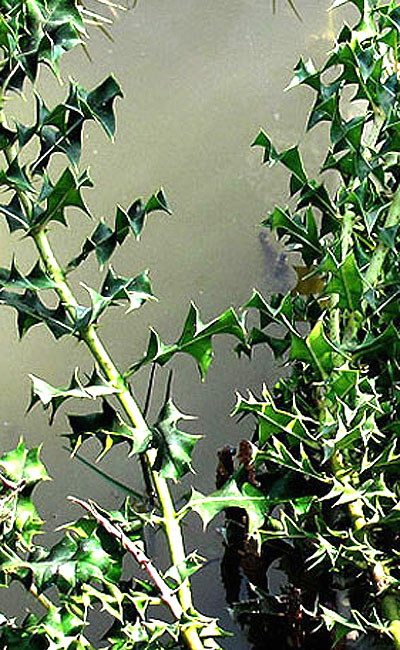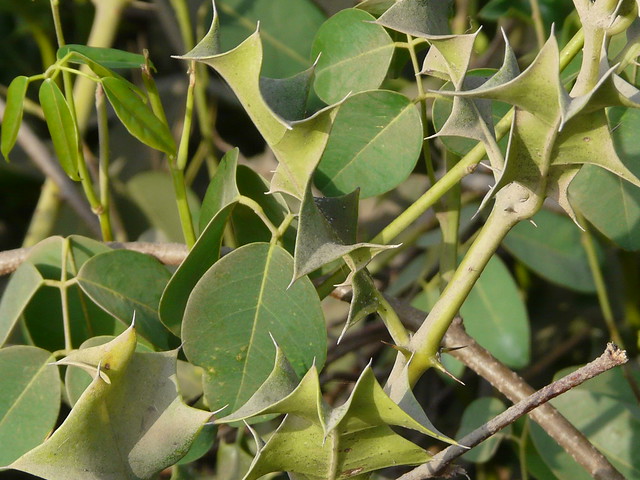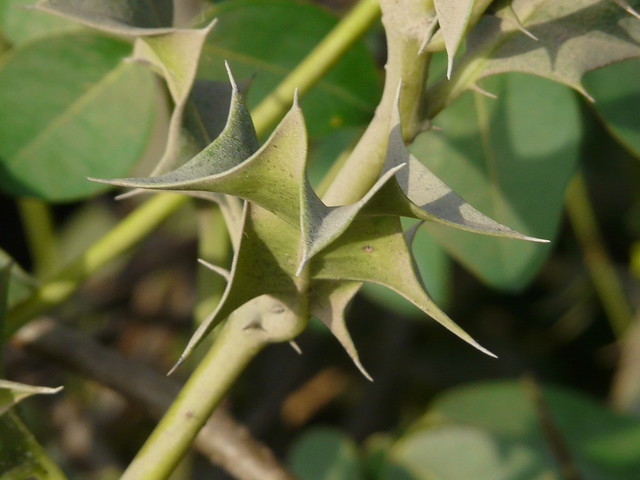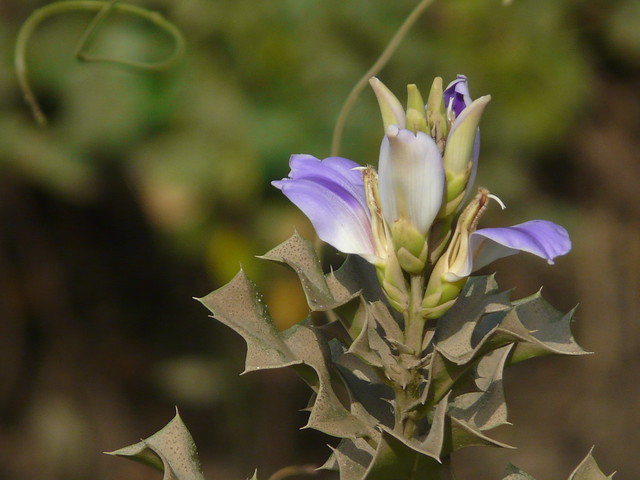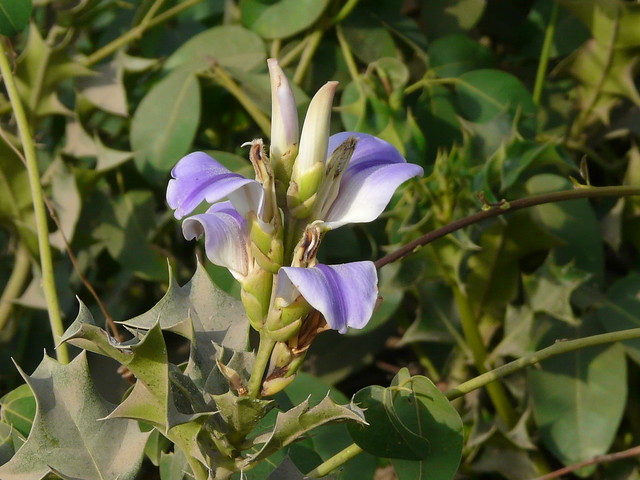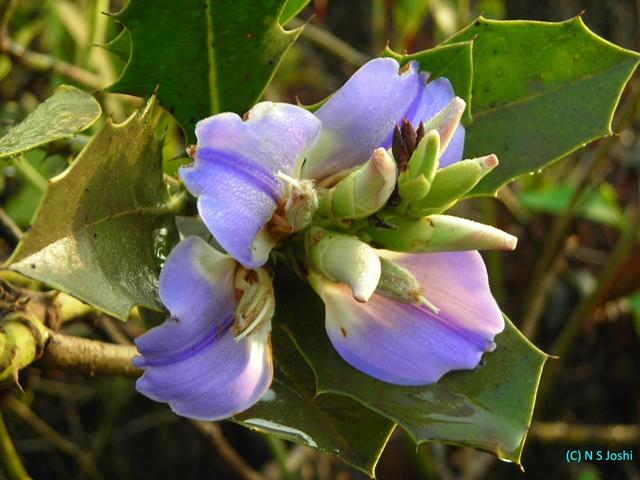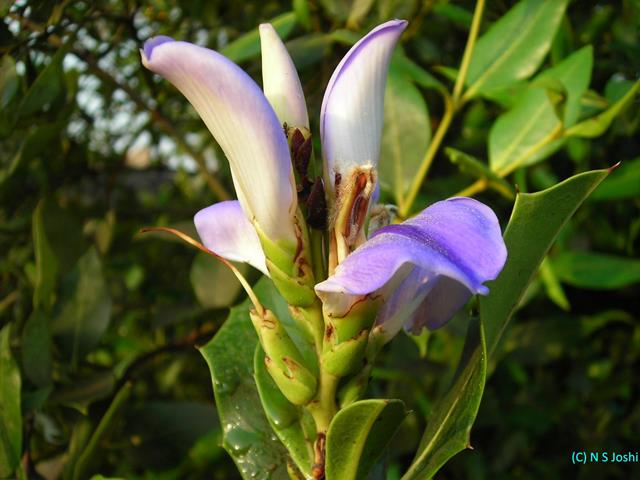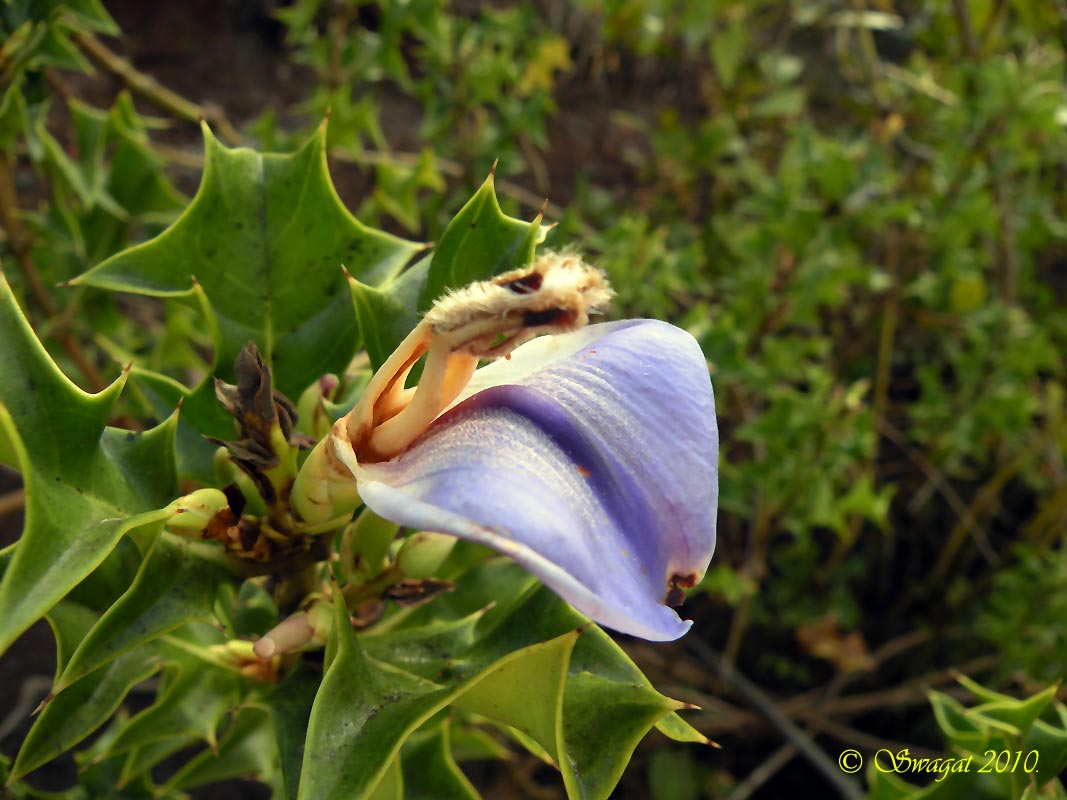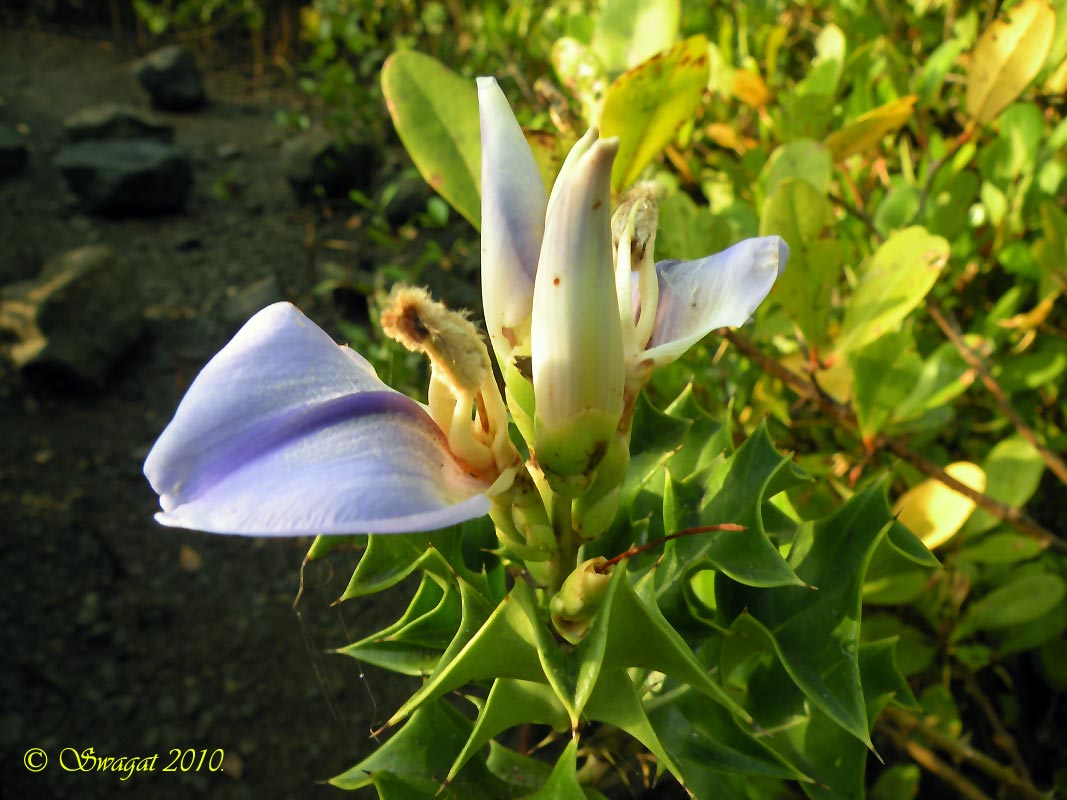|
Acanthus ilicifolius L., Sp. Pl. 639 1753. (Syn: Acanthus doloarin Blanco; Acanthus ilicifolius var. subinteger Nees; Acanthus neoguineensis Engl.; Dilivaria ilicifolia (L.) Juss.);
.
a-KANTH-us — Greek: ákantha (thorn); also spine or spike … Dave’s Botanary il-liss-ee-FOH-lee-us — having leaves like a holly … Dave’s Botanary . commonly known as: holly-leaved acanthus, holly-leaved bear’s breech, holly mangrove, sea holly • Bengali: হাড়গোজা hargoza, কটকি kataki, নীল টেংরাকাঁটা nila tenrakanta • Gujarati: હરગોજા hargoja, કાંટાળીયો kantaliyo Hindi: हड़कत harkata • Kannada: ಹೊಳೆ ಚುಳ್ಳಿ hole chulli, ಕಂಡ್ಲಾ ಚುಳ್ಳಿ kaandla chulli • Konkani: मारांडो maramdo • Malayalam: ചുള്ളി chulli, ചുള്ളിക്കണ്ടൽ chullikkantal, പയിങ്ങാച്ചുള്ളി payingngaachchulli • Marathi: मारांडी marandi, निवगूर nivagur, वागाटी vagati • Odia: ହାକୁଚ କଣ୍ଟା hakucha kanta, ହାଡ଼କାଠ harda katha, ହାଡ଼କଞ୍ଚି hardakanchi • Sanskrit: हरीकुसा harikusa • Tamil: ஆற்றுமுள்ளி arru-mulli, கழுதைமுள்ளி kalutai-mulli, கோழிமுள்ளி koli-mulli, உப்புக்கரிநீர்முள்ளி uppu-k-kari-nir-mulli • Telugu: అలస్యకంప alasyakampa, అలిసి alisi, ఏటిచిల్ల etichilla, తూడిచిల్ల thude chulli • Tulu: ತುದೆಚುಳ್ಳಿ tudechulli • Urdu: هڙکت harkata .
Names bibliography at https://dineshvalke.blogspot.com/2020/09/acanthus-ilicifolius-l.html
.
.
Acanthus ilicifolius@Devbagh beach resort.:
Acanthus ilicifolius @Devbagh beach resort. A mangrove species. [Efloraofindia_ Acanthus ilicifolius_031211PD04_ Flora of Odisha]: Name of the species: Acanthus ilicifolius
Family: Acanthaceae
Place of collection: Bhitarkanika, Kendrapada, Odisha
Habit: Perennial herb
Habitat: Wild, Wet evergreen forest
Yes truly ilicifolius This species (The root) is having very useful medicinal properties and used to treat bone fracture among other uses. The flowers are much liked by Black Beetles common in Bhitarkanika. It is polyphagus but prefers Acanthus ilicifolius flowers. I received specimen from the region many times and forwarded it to the Entomologists but failed to get correct identification. There is one more aspect of A. ilicifolius. The population of A. ilicifolius is a good indication of how healthy that particular mangrove forest is. If the population of this species is hight to very high, it is an indication of degraded land. That is to say, a healthy mangrove forest would have a limited population of A. ilicifolius! Absolutely right … this one of the ecological aspect of Mangroves and i can say as bioindication. Now a days the population of a. ilicifolius has come up to Rajnagar, around 60 km from estuary where once magrove was dominated. I found so many large patch of A. ilicifolius in Bhitarkanika.
Reminds me of Ilex aquifolium, but I may be wrong. This is Acanthus ilicifolius – commonly known as Sea Holy. A common Mangrove associate. Yes Acanthus ilicifolius Sharing Acanthus ilicifolius, a mangroves of River Kali. These areas are ideal for nature study, bird watching , boating, fishing etc.. Interesting plants of AJCB Indian Botanic Garden: SEA HOLLY (Acanthus ilicifolius ) from Shibpur, Howrah, India: SCFEB29 : Attachments (1). 2 posts by 2 authors. commonly known as Holly-leaved Acanthus, Sea Holly, and Holy Mangrove is a species of shrubs or herbs, of the plant family Acanthaceae, native to India, Sri Lanka, Asia, Malesia, Australia and Pacific Islands.
It is a small shrub growing along lakes and marshes and sea shores. It is used as medicine in asthma and rheumatism. Konkan, May 2014 :: Acanthus ilicifolius :: 27MAY2014 :: ARK-14 : 6 posts by 4 authors. Attachments (6). So beautiful images. Very beautiful flowers, seeing for the first time.. thanks for showing … Beautiful pictures. Have yet to see this plant. …, one plant is in Sagar Upvan…. Acanthaceae Fortnight :: Acanthus ilicifolius :: Thane & Sindhudurg :: DVMAR01/12 : 3 posts by 3 authors. Acanthus ilicifolius L.
at Vaghbil, Thane on April 27, 2008
in Sindhudurg on May 13, 2012
nice. holly leaved violet / white flowers of acanthaceae Acanthaceae Fortnight:: Acanthus ilicifolius :: NSJ-05 : 1 post by 1 author.
Acanthus ilicifolius (Sea Holly – Mangrove flower) Near Mahul, Mumbai Acanthaceae fortnight SN 11 : 1 post by 1 author. Attachments (1)
Acanthus ilicifolius L., erect stiff mangrove herb from Calicut, Kerala Acanthaceae Fortnight :: Acanthus ilicifolius :: Salim Ali WLS, Goa :: ARKMAR-60/72 : 1 post by 1 author. Attachments (4)
Attached are pictures of Acanthus ilicifolius captured at Salim Ali WLS, Goa in May 2014. Acanthaceae Fortnight ::Acanthus ilicifolius :: Mumbai::: PKA-MAR101/101:: : 1 post by 1 author. Attachments (1)
“Acanthus ilicifolius” from Mumbai. Acanthaceae Fortnight ::Acanthus ilicifolius :: Navi Mumbai::: PKA-MAR102/102:: : 1 post by 1 author. Attachments (7) Plant for ID-PC-27-24.08.2015 : 8 posts by 5 authors. Attachments (3) Please identify the plant from Warsaw University green house. I will be grateful. It seems Acanthus ilicifolius to me (aka Sea Holly) Acanthus Species for sure. Looks like Acanthus ilicifolius L: Check these websites : I agree with Acanthus ilicifolius as the most likely ID.
. commonly known as: holly-leaved acanthus, holly mangrove, sea holly • Bengali: hargoza • Hindi: हड़कत harkata •Kannada: ಹೊಳೆಸುಳ್ಳಿ holesulli • Konkani: मारांडो maramdo • Malayalam: ചക്കരമുള്ള് chakkaramullii • Marathi: मारंडी marandi, वागाटी vagati • Sanskrit: हरीकुसा harikusa • Tamil: கழுதைமுள்ளி kalutaimulli • Telugu: ఆలస్యకంప alasyakampa • Urdu: هڙکت harkata Please click on any name listed for this plant to view bibliographical details, AND if you would like to
If you know of any name(s) for this plant not listed here, please comment by clicking here. The contents in the above post shows a typical page of my site.
The site is very closely associated to our group and Flowers of India site and draws inspiration from both of them. xxxxxxxxxxxxxxxxxxxxxThe site makes an attempt to gather and share common names of the plants found in our country. My favourite say: The common names are just as important as the scientific names. Strangely — 1) some of the names are not common at all, and we may find them not known to us — 2) some of the common plants have no name at all !! Started the first page somewhere in Dec 2010, and to date have finished compiling just about 30 species of Acanthaceae. Building of the site is going to be a slow perennial process. Present activity is populating the names of native plants. The main focus of the site is validating the names that are put there, therefore the members of this group are earnestly requested to point out errors in the common names listed for the species. The regional names put in native script require stricter attention in terms of incorrect spelling. Members are also requested to provide any names that are not found listed for the species. Comments which help know the derivation of the common names are more than welcome. As such the site is not botanically inclined; comment(s) earnestly sought from members with scientific background for maintaining the accuracy of species’ current (accepted) name and the synonym(s) listed. xxxxxxxxxxxxxxxxxxxxx As and when time permits, I would be posting every species page in this group as a post to solicit validation of names from members of our group. Needless to say, critical comments are more than welcome to make the site easier to use. Thats going to be nice and informative. I will have a proper look after my deadline. It looks good, …
I strongly suggest you to include author citation for all botanical names, incl. accepted names, basionyms, and synonyms. The (author) names should be in abbreviated form following Brummitt & Powell’s book “Authors of Plant Names” or the related database. I earlier suggested the same for FOI site as well.pl also include family name for all taxa.at later stage, you may also like to provide the occurrence and distribution, brief description (not a technical one), local uses etc. for the benefit of users 🙂 …, many thanks for the pointer towards author citation … BUT am a little nervous about getting into it (ideally need not, with so many friends around me with clear knowledge).
Yet would rather take someone’s help in this regard who will provide me with this data for every species that I post here. Hopefully some friend(s) will come forward.Pankaj. many thanks for setting right the thoughts about “current” name … will soon incorporate it into my notes along with stress on synonyms (and basionym). And thanks too for the ilex name … will add it. … forgot to respond to your other points. About putting family names: had given a thought to it prior to settling at species level. Thanks …, for the response. The intention of the site is to gather the common names of plants in India and validate them.
The plant is introduced by its Latin name because it is unique and not shared. When in case there are instances of a Latin name with more than one author, their authors’ names will follow them for sake of differentiation. xxxxxxxxxxxxxxxAt NPGS / GRIN … http://www.ars-grin.gov/cgi-bin/npgs/html/taxon.pl?1079 … put as Acanthus ilicifolius L. … no synonyms put at present. Not able to understand the format at IPNI … http://www.ipni.org/ipni/idPlantNameSearch.do?id=84648-3 GBIF at http://data.gbif.org/species/14807706/ has Acanthus ilicifolius Lour. … was not able to know where the synonyms are putAt some other places on WWW 1) Acanthus ilicifolius Linn. Synonyms: Acanthus doloariu Blanco., Acanthus ebracteatus val., Acanthus volubilis Wall., Dilivaria ilicifolia Nees. (Juss ) 2) Acanthus ilicifolius L. Synonym: Acanthus volubilis Wallich. Have stayed far away from gathering data related to botanical name citations because of differing abbreviations (implying different authors AND / OR different syntax). xxxxxxxxxx The data is not stored in database format. In the given circumstances, change in status of botanical name is the least that can be afforded (time-wise and efforts-wise). The site and its contents at present are viewable only to our group … as such is matter for discussing / validating the common names … not to be considered as database. xxxxxxxxxxxxxx Please note this response is copied to ITPMods, and cut from the entire group. Thanks …, for the clarification. These are my responses for your queries: 1. Use of two names L. and Linn. is accepted only for Linnaeus (may be due to the long usage of Linn.). So its OK if you use either of these. But nowadays only L. is used. Using Linn. in not a mistake. Many thanks … for the clarifications. If you find any discrepancies OR would like to comment on any other aspect please do so by posting it to our group. Can’t believe that you are a nonbotnist. a-KANTH-us — Greek: ákantha (thorn); also spine or spike … Dave’s Botanary
il-liss-ee-FOH-lee-us — having leaves like a holly … Dave’s Botanary.commonly known as: holly-leaved acanthus, holly-leaved bear’s breech, holly mangrove, sea holly • Bengali: হাড়গোজা hargoza, কটকি kataki, নীল টেংরাকাঁটা nila tenrakanta • Gujarati: હરગોજા hargoja, કાંટાળીયો kantaliyo Hindi: हड़कत harkata • Kannada: ಹೊಳೆ ಚುಳ್ಳಿ hole chulli, ಕಂಡ್ಲಾ ಚುಳ್ಳಿ kaandla chulli • Konkani: मारांडो maramdo • Malayalam: ചുള്ളി chulli, ചുള്ളിക്കണ്ടൽ chullikkantal, പയിങ്ങാച്ചുള്ളി payingngaachchulli • Marathi: मारांडी marandi, निवगूर nivagur, वागाटी vagati • Odia: ହାକୁଚ କଣ୍ଟା hakucha kanta, ହାଡ଼କାଠ harda katha, ହାଡ଼କଞ୍ଚି hardakanchi • Sanskrit: हरीकुसा harikusa • Tamil: ஆற்றுமுள்ளி arru-mulli, கழுதைமுள்ளி kalutai-mulli, கோழிமுள்ளி koli-mulli, உப்புக்கரிநீர்முள்ளி uppu-k-kari-nir-mulli • Telugu: అలస్యకంప alasyakampa, అలిసి alisi, ఏటిచిల్ల etichilla, తూడిచిల్ల thude chulli • Tulu: ತುದೆಚುಳ್ಳಿ tudechulli • Urdu: هڙکت harkatabotanical names: Acanthus ilicifolius L. … synonyms: Acanthus doloarin Blanco • Dilivaria ilicifolia (L.) Juss. … status at The Plants List (2013). Version 1.1. Bibliography / etymology
~~~~~ ENGLISH ~~~~~
holly-leaved acanthus
holly-leaved bear’s breech
holly mangrove
sea holly
~~~~~ BENGALI ~~~~~
হরগজা haragoza
কটকি kataki
নীল টেংরাকাঁটা nila tenrakanta
~~~~~ GUJARATI ~~~~~
હરગોજા hargoja
કાંટાળીયો kantaliyo
~~~~~ HINDI ~~~~~
हड़कत harkata
~~~~~ KANNADA ~~~~~
ಹೊಳೆ ಚುಳ್ಳಿ hole chulli
ಕಂಡ್ಲಾ ಚುಳ್ಳಿ kaandla chulli
~~~~~ KONKANI ~~~~~
मारांडो maramdo
~~~~~ MALAYALAM ~~~~~
ചുള്ളി chulli
ചുള്ളിക്കണ്ടൽ chullikkantal
പയിങ്ങാച്ചുള്ളി payingngaachchulli
~~~~~ MARATHI ~~~~~
मारांडी marandi
निवगूर nivagur
वागाटी vagati
~~~~~ ODIA ~~~~~
ହାକୁଚ କଣ୍ଟା hakucha kanta
ହାଡ଼କାଠ harda katha
ହାଡ଼କଞ୍ଚି hardakanchi
~~~~~ SANSKRIT ~~~~~
हरीकुसा harikusa
~~~~~ TAMIL ~~~~~
ஆற்றுமுள்ளி arru-mulli
கழுதைமுள்ளி kalutai-mulli
கோழிமுள்ளி koli-mulli
உப்புக்கரிநீர்முள்ளி uppu-k-kari-nir-mulli
~~~~~ TELUGU ~~~~~
అలస్యకంప alasyakampa
అలిసి alisi
ఏటిచిల్ల etichilla
తూడిచిల్ల thude chulli
~~~~~ TULU ~~~~~
ತುದೆಚುಳ್ಳಿ tudechulli
~~~~~ URDU ~~~~~
هڙکت harkata
~~~~~ x ~~~~~
Names compiled / updated at https://dineshvalke.blogspot.com/2020/09/acanthus-ilicifolius-l.html . Plant for ID: Koonammavu: Kerala: 8/7/2021: 3 images.
Please help ID this wild plant that grows beside a waterbody in Koonammavu, Kerala. The area has saline water. This plant is 4-6 feet tall, and produces small, light purple flowers. This is unfortunately not the flowering season. A guess: Ilex aquifolium– in the absence of flowers and fruits it is a wild guess. Acanthus ilicifolius Ilex aquifolium does not look right since this plant does not have the characteristic red fruits.
Acanthus ilicifolius looks right, https://sites.google.com/site/efloraofindia/species/a—l/a/acanthaceae/acanthus/acanthus-ilicifolius. I am surprised that some plants have leaves with straight margins, and some have holly-like leaves. That is why I said it is a guess in the absence of fruits or flowers in your posting. Thanks … for the correct ID. . Acanthus ilicifolius L. :: Waghbil, Thane, Maharashtra :: Apr 27, 2008 · JUN23 DV179: 1 image. Acanthus ilicifolius L.
Waghbil, Thane, Maharashtra :: Apr 27, 2008 · 5:16 PM IST :: about 3 m (10 ft) asl
Earlier uploaded at efloraofindia . Acanthus ilicifolius L. :: Shirgaon, Palghar :: Feb 26, 2023 · JUN23 DV413: 2 images. Acanthus ilicifolius L.
Shirgaon, Palghar :: Feb 26, 2023 · 12:09 PM IST :: about 14 m (46 ft) asl
Many thanks to Radha Veach and Bharat Godambe for validating the ID at iNaturalist .
Acanthus ilicifolius??: 2 images.
Posting again from … as earlier posted without subject and got clubbed many other posts:
Is the plant species is Acanthus ilicifolius,??,
collected from estuarine wetland, West Bengal Acanthus ilicifolius L. . References:
|
Acanthus ilicifolius
Updated on September 9, 2025


